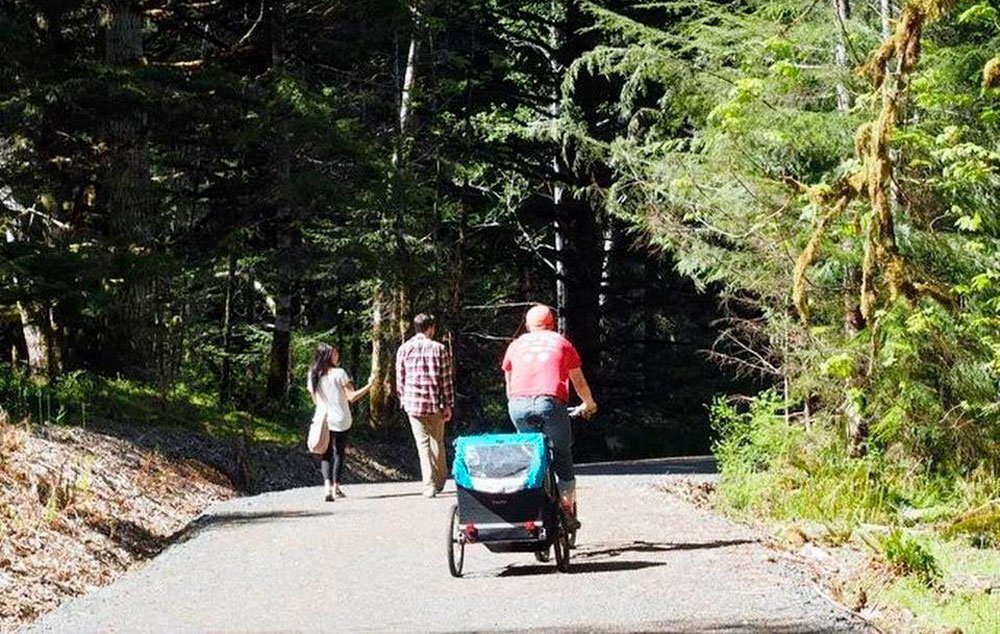A new book offers barrier-free tips for visiting Mount Rainier and Olympic national parks.
“Barrier-Free Travel: Olympic and Mount Rainier National Parks for Wheelers and Slow Walkers” was written by accessible travel expert Candy Harrington. In the new travel guide, Harrington writes about accessible trails, sites and lodging options in the two national parks.
Harrington said she realized such a guide was needed when her preliminary research discovered conflicting and inaccurate access information.
“It seemed like all the trails were rated as ‘accessible with assistance,’ when in fact some were fine for wheelchair-users, while others were more appropriate for mountain goats,” she said.
The need for the book was driven home when Harrington was directed to a wheelchair accessible trail by an employee at Olympic.
“I arrived to find that it had 24 steps. That was the last straw. I knew I had to write an access guide with accurate trail descriptions,” she added. “She did say that a wheelchair-user would need ‘a little assistance.’ I expect that she figured that since parents are able to carry strollers up stairs, then the same thing can be done for wheelchair-users. I think she just wasn’t familiar with access issues.”
Harrington said, after visiting both parks while researching the book, she felt the two parks were about average for national parks when it comes to accessibility.
“The natural environment presents many challenges for access, but both parks have accessible trails and lodging options,” she said.
The situation will improve at Olympic when the Spruce Railroad Trail project along Lake Crescent is completed. The park is working to make another 1,800 feet of the trail accessible. The work is expected to be done in October. This year’s work is part of a multi-phase effort that will make the entire 9.8-mile trail accessible.
“When completed, it will triple the length of accessible trails in the park,” she said. “That’s one of the reasons that I wrote the book, because of the upcoming (and ongoing) access improvements.”
The book includes information on accessible ranger-led tours, barrier-free camping, scenic drives and accessible viewpoints in the parks, accessible lodging and trails near the park entrances and the locations of loaner wheelchairs.
One reason Harrington wrote the book is to give users a better understanding of what they will face when coming to the parks.
“I felt the book was needed because most of the trails in these parks are rated as ‘accessible with assistance.’ That is such a general term, and I understand why it was used, but it doesn’t do visitors any good,” she said.
The “accessible with assistance” trails range from those with few obstacles to those that are almost impassable to wheelchair-users.
“My job is to describe the access, so my readers can decide if it’s doable for them,” she said.
She pointed out, however, the information also is usable for other park visitors.
“Although it’s written for wheelchair-users and slow walkers, moms who have stroller-aged kids will appreciate the access information in this guide. In the end, good access really benefits everyone.”
This is Harrington’s seventh in a series of guides on accessible travel to popular destinations in the United States, including two on national parks. The founding editor of Emerging Horizons, she also wrote “Barrier-Free Travel: A Nuts and Bolts Guide for Wheelers and Slow Walkers.” Harrington has been writing on the topic for 20 years.
GET THE BOOK
WHAT: “Barrier-Free Travel: Olympic and Mount Rainier National Parks for Wheelers and Slow Walkers”
PUBLISHER: C&C Creative Concepts.
PRICE: $5.99.
INFORMATION: Go to barrierfreeolympic.com.
RECOMMENDED TRAILS
MOUNT RAINIER: Harrington recommends the Kautz Creek Trail. The trailhead is about 5 miles east of the Nisqually entrance, across the street from the Kautz Creek picnic area. The level boardwalk trail winds through the forest out to an accessible overlook, where visitors can get an excellent view of Mount Rainier. “They really did a great job with the access on this trail,” Harrington said.
OLYMPIC: Her current choice is the Moments in Time Trail near Lake Crescent Lodge. This hard-packed dirt trail is covered with crushed granite. Aside from a few roots here and there, it’s doable for most folks, as the obstructions are easy to dodge, Harrington said. “But I also encourage folks to keep an eye on the Spruce Railroad Trail as the renovation project progresses, because every year, more of this trail will be accessible, until 2018 when wheelchair-users and slow walkers will be able to access the entire length of it,” she said.
Source: The News Tribune



